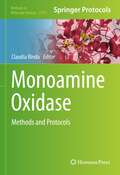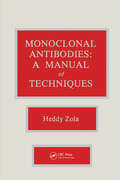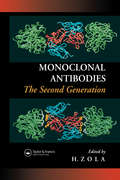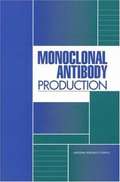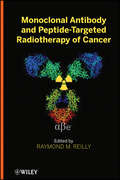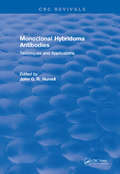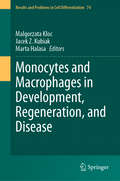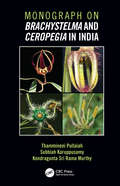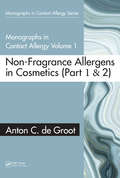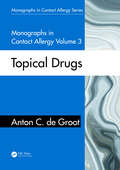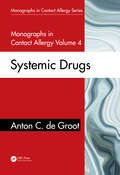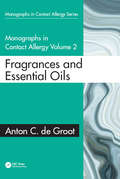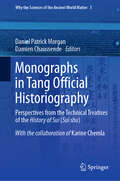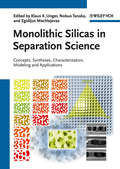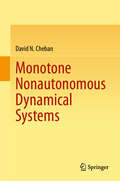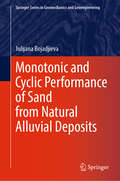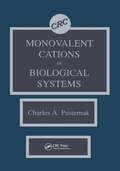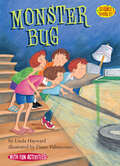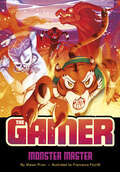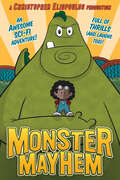- Table View
- List View
Monoamine Oxidase: Methods and Protocols (Methods in Molecular Biology #2558)
by Claudia BindaThis detailed book examines the main methods to study mammalian monoamine oxidases (MAOs), ranging from cell biology to computational chemistry. Beginning with techniques on how to obtain pure samples of MAO A and MAO B, the volume continues by covering assays and techniques used to measure MAO enzymatic activity and perform inhibition studies, methods to address cellular localization and function of MAOs, either in cell lines or in animal models, as well as computational methods applied to rational drug design approaches that are used to develop new MAO inhibitors. Written for the highly successful Methods in Molecular Biology series format, chapters include introductions to their respective topics, lists of the necessary materials and reagents, step-by-step and readily reproducible laboratory protocols, and tips on troubleshooting and avoiding known pitfalls. Authoritative and practical, Monoamine Oxidase: Methods and Protocols serves as a vital resource for scientists who are interested in studying MAOs and other similar amine oxidase enzymes.
Monoclonal Antibodies
by Maher AlbitarThis book examines a collection of state-of-the-art methods that employ monoclonal antibodies in a clinical setting. The chapters offer in-depth description for generating mouse and recombinant humanized antibodies, and a comprehensive review of how antibodies are being used in bead-based methods for measuring proteins. This field will continue to expand and provide new and innovative techniques in the laboratory and as a basis that complements targeted therapy.
Monoclonal Antibodies & T Cell Products (Routledge Revivals)
by David H. KatzFirst Published in 1982, this book offers a full, comprehensive guide into the applications of Monoclonal Antibodies. Carefully compiled and filled with a vast repertoire of notes, diagrams, and references this book serves as a useful reference for Students of Medicine, and other practitioners in their respective fields.
Monoclonal Antibodies: A Manual of Techniques
by Heddy ZolaThis book describes, in detail, tested techniques for the produc-tion and use of monoclonal antibodies. It covers those aspects of interest to all scientists working with monoclonal antibodies and presents methods in a step-by-step format for easy refer-ence. The text serves as a laboratory manual; and discusses rationale behind each method, and th
Monoclonal Antibodies: The Second Generation
by Heddy ZolaA review of what needs to be done to realise the potential of monoclonal antibodies. The book assesses the competing technologies with advice on the best approach for a particular situation.
Monoclonal Antibody Production
by National Research CouncilInformation on Monoclonal Antibody Production
Monoclonal Antibody and Peptide-Targeted Radiotherapy of Cancer
by Raymond M. ReillyOncology Book of 2011, British Medical Association's Medical Book AwardsAwarded first prize in the Oncology category at the 2011 BMA Medical Book Awards, Monoclonal Antibody and Peptide-Targeted Radiotherapy of Cancer helps readers understand this hot pharmaceutical field with up-to-date developments. Expert discussion covers a range of diverse topics associated with this field, including the optimization of design of biomolecules and radiochemistry, cell and animal models for preclinical evaluation, discoveries from key clinical trials, radiation biology and dosimetry, and considerations in regulatory approval. With chapters authored by internationally renowned experts, this book delivers a wealth of information to push future discovery.
Monoclonal Hybridoma Antibodies: Techniques and Applications
by John G.R. HurrellThe first section of this volume is aimed to provide a comprehensive review of the many varied and often empirically derived techniques and procedures currently in use to produce monoclonal hybridoma cell lines and to characterize the antibodies secreted. The goal has been achieved with the chapter contributed by Zola and Brookes who, as each step in the process of hybridoma production and antibody characterisation is reviewed, have provided an experimental procedure found to be satisfactory in their laboratory.The second section of this volume is designed to provide a review of areas in which monoclonal hybridoma antibodies have been of particular advantage. This is a rapidly advancing field which could not be thoroughly reviewed in a single volume.
Monocytes and Macrophages in Development, Regeneration, and Disease (Results and Problems in Cell Differentiation #74)
by Jacek Z. Kubiak Malgorzata Kloc Marta HalasaThe study and therapeutic application of macrophages is a rapidly developing field. Tremendous progress has been made in understanding the phenotypes and functions of macrophages in healthy and diseased tissues and organs. Following the great success of Volume 62: "Macrophages - Origin, Functions and Biointervention" published in this series, this new book now focuses on the role of monocytes and macrophages in development, regeneration and disease. This new volume offers an overview of the latest developments in monocyte and macrophage subtypes and functions across various tissues including adipose tissue, bones, liver, lungs, testes, and the nervous system. The book also reviews existing and potential therapies targeted towards the macrophages and describes their homeostatic functions. It explores how macrophage cell cycle, metabolism, mitochondrial activity, histone acetylation status, and interaction with the extracellular matrix contribute to changes in macrophage phenotype and function in health and disease. Additionally, it examines the interactions between macrophages and cancer cells, bacteria, helminth parasites, and their role in the colonization and spread of HIV. For ease of reference, the volume is divided into three sections: Part I Nonimmunologic and immunologic functions of monocytes/macrophages Part II Tissue/organ specific functions of macrophages Part III Macrophage functions and dysfunction in diseases This book will be of interest to researchers working in the fields of developmental biology, immunology, cancer research, and therapeutic applications. It is written to inform and inspire experts and newcomers to the field of macrophages.
Monodisperse Highly Ordered and Polydisperse Biobased Solid Foams (Springer Theses)
by Sébastien AndrieuxThis book discusses the synthesis of chitosan-based solid foams using foam templating. Solid foams with pore sizes between a few micrometres and a few millimetres are widely used in a range of established and emerging applications, including filtration, catalysis, sound and thermal insulation, human protection, and tissue engineering. They are lightweight with large surface-to-volume ratios, and have excellent mechanical, acoustic, and thermal properties. However, most foaming processes are extremely complex, and there remains a lack of sound scientific understanding of—and therefore control over—the parameters that determine the properties of the material. One route towards tailor-made solid foams is liquid foam templating, where the liquid foam is generated first (with the desired structure) before being solidified into a solid foam with the desired structure. This book describes how liquid foam templating can be used to synthesise monodisperse solid foams as well as solid foams with a tuneable polydispersity.
Monograph on Brachystelma and Ceropegia in India
by Thammineni Pullaiah Subbiah Karuppuswamy Kondragunta Sri Rama MurthyThe book provides data on all the species of the two genera Genera Brachystelma Sims and Ceropegia L. in India for their bioprospection and conservation. The other objectives are to promote the beauty and uniqueness of the species of these two genera and also to provide medicinal and edible uses for bioprospection.
Monographs in Contact Allergy, Volume 1: Non-Fragrance Allergens in Cosmetics (Part 1 and Part 2) (Monographs in Contact Allergy #1)
by Anton C. de GrootMonographs in Contact Allergy, Volume 1: Non-Fragrance Allergens in Cosmetics (Part 1 and Part 2) is the first 2-part volume in an exciting series on contact allergy. It presents over 500 natural or synthetic chemicals and compounds which have caused allergic contact dermatitis in cosmetic products. Included here are INCI names, synonyms, description/definition, CAS and EU numbers, chemical class, function in cosmetics, molecular formula, structural formula and advice on patch tests. A full literature review is given of patch testing in patients, case reports of cosmetic allergic contact dermatitis, irritant contact dermatitis, photosensitivity, immediate contact reactions and systemic side effects. This text is suitable for anyone with an interest in contact allergy, from university students to professionals, and all readers will find this informative and detailed series an invaluable resource. Key Features: Monographs of all known non-fragrance chemicals and substances which have caused allergic contact dermatitis from their presence in cosmetic products Provides lists of all functional groups (such as antioxidants, preservatives, artificial nail building, emollients, hair dyeing, hair colorants) in both the EU and US formats and all chemicals in these groups which have caused cosmetic allergy Presents an alphabetical list of all synonyms indicating their INCI names Reported cross-reactions, pseudo-cross-reactions and co-reactions, patch test sensitization and presence in cosmetic products (including data from FDA’s Voluntary Cosmetic Registration Program) and chemical analyses are discussed Covers an extensive amount of information to benefit dermatologists, allergists, and non-medical professionals involved with the research, development and marketing of cosmetic products
Monographs in Contact Allergy, Volume 3: Topical Drugs (Monographs in Contact Allergy #4)
by Anton C. de GrootThis third volume in an exciting and detailed series on contact allergens provides monographs of all 384 topical drugs which have caused contact allergy/allergic contact dermatitis. The monographs present: Identification section; Contact allergy (general population, patients with dermatitis, case reports and case series); Cross-reactions; Patch test sensitization; Photocontact allergy; and Immediate contact reactions (contact urticaria). Separate chapters present an overview of all aspects of allergic contact dermatitis to topical drugs, contact allergy to non-drug ingredients in topical pharmaceuticals and a preview of delayed-type allergy to systemic drugs (to be discussed in Volume 4). Key Features: Presents monographs of all known topical drugs which have caused contact allergy/allergic contact dermatitis Provides a full literature review of relevant topics of allergenic topical drugs Identifies IUPAC names, synonyms, CAS and EC numbers, structural and chemical formulas, Merck Index monographs, and advises on patch testing Presents non-drug allergens in topical pharmaceuticals Covers an extensive amount of information to benefit dermatologists, allergists, and all others interested in drug allergy
Monographs in Contact Allergy, Volume 4: Systemic Drugs (Monographs in Contact Allergy #4)
by Anton C. de GrootThis fourth volume in an exciting and detailed series on contact allergens and drug allergy provides monographs of all 507 systemic drugs which have caused delayed-type cutaneous drug hypersensitivity reactions and/or occupational allergic contact dermatitis. The monographs present: Identification section; Occupational allergic contact dermatitis; and Cutaneous adverse drug reactions from systemic drugs caused by type IV (delayed-type) hypersensitivity, as shown by positive patch tests (e.g. maculopapular eruption, acute generalized exanthematous pustulosis [AGEP], symmetrical drug-related intertriginous and flexural exanthema [SDRIFE], fixed drug eruption, drug reaction with eosinophilia and systemic symptoms [DRESS], and photosensitivity). Separate chapters present an overview of the spectrum of allergic cutaneous drug reactions, diagnostic tests, immediate contact reactions (contact urticaria), and systemic drugs that have acquired delayed-type hypersensitivity only by cross-reactivity. Key Features: Presents monographs of all known systemic drugs which have caused delayed allergic cutaneous drug reactions and/or occupational allergic contact dermatitis Provides an extensive literature review of relevant topics of allergenic systemic drugs, part of which is hard or impossible to find in database searches Identifies IUPAC names, synonyms, CAS and EC numbers, structural and chemical formulas, Merck Index monographs, and advises on patch testing Presents immediate contact reactions (contact urticaria) from systemics drugs and delayed-type hypersensitivity in drugs caused only by cross-reactivity Covers an extensive amount of information to benefit dermatologists, allergists, and all others interested in drug allergy
Monographs in Contact Allergy: Fragrances and Essential Oils (Monographs in Contact Allergy #2)
by Anton C. de GrootThis second volume in an exciting and detailed series on contact allergens provides monographs of all 181 fragrances and 79 essential oils which have caused contact allergy / allergic contact dermatitis, including the indicators for fragrance allergy (fragrance mixes I and II and Myroxylon pereirae resin [Balsam of Peru]) and non-fragrance allergens in botanical products used in the perfume industry. The monographs present: Identification section; Contact allergy (general population, patients with dermatitis, case reports and case series); Cross-reactions; Patch test sensitization; Presence in products and chemical analyses; Other side effects (irritant contact dermatitis, photosensitivity, immediate-type reactions, systemic side effects) and more. Key Features: Presents monographs of all known fragrance chemicals and essential oils which have caused contact allergy / allergic contact dermatitis Provides a full literature review of relevant topics of allergenic fragrances and essential oils Identifies INCI and IUPAC names, synonyms, CAS and EC numbers, structural formulas, RIFM and Merck Index monographs, SCCS opinions, IFRA and EU restrictions and advises on patch testing Presents an alphabetical list of all synonyms indicating their INCI names Covers an extensive amount of information to benefit dermatologists, allergists, and non-medical professionals involved with the research, development and marketing of fragrances and essential oils
Monographs in Tang Official Historiography: Perspectives from the Technical Treatises of the History of Sui (Sui shu) (Why the Sciences of the Ancient World Matter #3)
by Daniel Patrick Morgan Damien ChaussendeThis book examines the role of medieval authors in writing the history of ancient science. It features essays that explore the content, structure, and ideas behind technical writings on medieval Chinese state history. In particular, it looks at the Ten Treatises of the current History of Sui, which provide insights into the writing on the history of such fields as astronomy, astrology, omenology, economics, law, geography, metrology, and library science. Three treatises are known to have been written by Li Chunfeng, one of the most important mathematicians, astronomers, and astrologers in Chinese history.The book not only opens a new window on the figure of Li Chunfeng by exploring what his writings as a historian of science tell us about him as a scientist and vice versa, it also discusses how and on what basis the individual treatises were written.The essays address such themes as (1) the recycling of sources and the question of reliability and objectivity in premodern history-writing; (2) the tug of war between conservatism and innovation; (3) the imposition of the author’s voice, worldview, and personal and professional history in writing a history of a field of technical expertise in a state history; (4) the degree to which modern historians are compelled to speak to their own milieu and ideological beliefs.
Monolithic Silicas in Separation Science: Concepts, Syntheses, Characterization, Modeling and Applications
by Klaus K. Unger Egidijus Machtejevas Nobuo TanakaEdited by the experts and pioneers in the field, this is the first monograph to cover the topic, containing the must-have information hitherto only scattered among journals. Clearly divided into sections on preparation, characterization and modeling, and applications, this is essential reading for chemists, chromatographers, analytical chemists, biochemists and biologists.
Monooxygenase, Peroxidase and Peroxygenase Properties and Mechanisms of Cytochrome P450
by Eugene G. Hrycay Stelvio M. BandieraThis book describes in 13 chapters mechanisms of P450 used to monooxygenate substrates via the NAD(P)H/O2 pathway using its peroxidase and peroxygenase functions. P450 also utilizes peroxides, peracids, periodate and iodosobenzene to oxygenate substrates via the shunt pathway. Also described are mechanisms used in the oxidation of pharmaceuticals by CYP3A4; acyl- carbon cleavage by CYP17A1, CYP19A1 and CYP51A1; metabolism of tetrabromodiphenyl ethers and bile acids by CYP2B6 and CYP3A4; metabolism of ω-6 and ω-3 polyunsaturated fatty acids; H2O2-mediated peroxygenation of substrates using substrate misrecognition; P450 oxidative reactions using electrochemical methods; electron transfer to P450 by redox proteins; hydroxylation of 1,8-cineole by P450cin; and peroxygenation by unspecific peroxygenases using H2O2. The topics covered are relevant to P450 researchers, professors and students from a variety of disciplines ranging from pharmacology, toxicology and microbiology to chemistry.
Monotone Nonautonomous Dynamical Systems
by David N. ChebanThe monograph present ideas and methods, developed by the author, to solve the problem of existence of Bohr/Levitan almost periodic (respectively, almost recurrent in the sense of Bebutov, almost authomorphic, Poisson stable) solutions and global attractors of monotone nonautonomous differential/difference equations. Namely, the text provides answers to the following problems: 1. Problem of existence of at least one Bohr/Levitan almost periodic solution for cooperative almost periodic differential/difference equations; 2. Problem of existence of at least one Bohr/Levitan almost periodic solution for uniformly stable and dissipative monotone differential equations (I. U. Bronshtein’s conjecture, 1975); 3. Problem of description of the structure of the global attractor for monotone nonautonomous dynamical systems; 4. The structure of the invariant/minimal sets and global attractors for one-dimensional monotone nonautonomous dynamical systems; 5. Asymptotic behavior of monotone nonautonomous dynamical systems with a first integral (Poisson stable motions, convergence, asymptotically Poisson stable motions and structure of the Levinson center (compact global attractor) of dissipative systems); 6. Existence and convergence to Poisson stable motions of monotone sub-linear nonautonomous dynamical systems. This book will be interesting to the mathematical community working in the field of nonautonomous dynamical systems and their applications (population dynamics, oscillation theory, ecology, epidemiology, economics, biochemistry etc). The book should be accessible to graduate and PhD students who took courses in real analysis (including the elements of functional analysis, general topology) and with general background in dynamical systems and qualitative theory of differential/difference equations.
Monotonic and Cyclic Performance of Sand from Natural Alluvial Deposits (Springer Series in Geomechanics and Geoengineering)
by Julijana BojadjievaThis book presents a comprehensive experimental investigation, consisting of element scale—triaxial and simple shear tests and model scale—shaking table tests, to examine the monotonic and cyclic behavior of Skopje sand. Skopje sand is silica sand from natural alluvial river deposits collected from the river terraces of Vardar river in the city of Skopje, Macedonia. Numerical simulation of the element monotonic and cyclic tests is also presented using the hypoplastic material model. Particular focus is given on the liquefaction potential of the tested material. While there were no well-documented cases of liquefaction during the 1963 Skopje earthquake with a magnitude of 6.1, significant structural damage was attributed to pronounced site amplification effects of sand materials in the Vardar valley. Given the absence of seismic geotechnical codes in the region at that time, the lack of a seismic monitoring network, and limited knowledge about the city's geotechnical properties, there is the assumption that liquefaction might have occurred but went undocumented and unassessed due to the overwhelming structural damage and other post-earthquake disaster management activities. The generated experimental data of Skopje sand serve as a foundational dataset for students and researchers into continuous more advanced experimental research in the field, validating numerical modeling focusing on liquefaction phenomena, soil dynamics, induced settlement of buildings, and evaluating effective mitigation strategies. The conducted investigations provide a strong basis for sustainable research on element and model scale in the Laboratory for Soil Dynamics and Geotechnical Engineering at the Department of Geotechnics and Special Structures, Institute of Earthquake Engineering and Engineering Seismology-IZIIS, Skopje, Macedonia.
Monotonic and Ultra-Low-Cycle Fatigue Behaviour of Pipeline Steels: Experimental and Numerical Approaches
by Renato Natal Jorge António Augusto Fernandes Abílio M.P. JesusThis book covers the development of innovative computational methodologies for the simulation of steel material fracture under both monotonic and ultra-low-cycle fatigue. The main aspects are summarised as follows: i) Database of small and full-scale testing data covering the X52, X60, X65, X70 and X80 piping steel grades. Monotonic and ULCF tests of pipe components were performed (buckled and dented pipes, elbows and straight pipes). ii) New constitutive models for both monotonic and ULCF loading are proposed. Besides the Barcelona model, alternative approaches are presented such as the combined Bai-Wierzbicki-Ohata-Toyoda model. iii) Developed constitutive models are calibrated and validated using experimentally derived testing data. Guidelines for damage simulation are included. The book could be seen as a comprehensive repository of experimental results and numerical modeling on advanced methods dealing with Ultra Low Cycle Fatigue of Pipelines when subjected to high strain loading conditions.
Monovalent Cations in Biological Systems
by Charles A. PasternakThis unique volume provides an integrated overview of the subject of monovalent cations, specifically aimed at students and researchers. It is divided into two parts: the first deals with the processes by which monovalent cations are transported across biological membranes; the second deals with the processes that are affected by changes in intracellular cations. Each chapter describes in simple biochemical terms the interaction between one or more monovalent cations and a particular biological system of importance to current understanding of body function in health and disease. This useful publication is invaluable to students and researchers in biochemistry, physiology, neurology, pharmacology, anesthesiology, cardio-pulmonology, hematology, laboratory medicine, endocrinology, gastroenterology, internal medicine, psychiatry, urology, biomedical physics and medical nutrition.
Monster Bug (Science Solves It!)
by Linda HaywardSolve kid-sized dilemmas and mysteries with the Science Solves It! series. These fun books for kids ages 5–8 blend clever stories with real-life science. Why did the dog turn green? Can you control a hiccup? Is that a UFO? Find the answers to these questions and more as kid characters dive into physical, life, and earth sciences. Jenna and Kyle's older siblings tease them constantly! After noticing shadows during a day at the beach, Kyle devises a plan to get back at the older kids. All it takes is a flashlight, a lobster costume, and a little creativity. Books in this perfect STEM series will help kids think like scientists and get ahead in the classroom. Activities and experiments are included in every book! (Level One; Science topic: Shadows)
Monster Master (The Gamer)
by Shawn PryorThe Gamer's friends are in beastly trouble! Villain Cynthia Cyber has trapped them in her dangerous Power Combat video game. If the Gamer isn’t able to rescue his friends in just ten minutes, they’ll be stuck in the electronic world forever as monsters! Can the Gamer make the save before it’s too late?
Monster Mayhem
by Christopher EliopoulosFrom the creator of Cosmic Commandos comes a funny, action-packed graphic novel adventure—when a science-obsessed girl finds herself in the middle of one of her favorite monster movies, can she invent her way out of disaster while also saving the monster who has become her friend?Zoe's favorite thing to do—besides invent and build robots—is watch classic monster movies. She has never been comfortable with kids her own age, and so she pretends she doesn't need friends while inside she's longing for connection. And then one day, Zoe finds a mysterious ring on her way home from school. She puts it on, gives it a twist, and—FRZAAKK! There's a massive burst of light! The next morning, a familiar monster appears at Zoe's window. He's from one of her favorite kaiju movies, and he likes Zoe—he wants to be her friend. Has her secret wish been fulfilled? But it turns out that Zoe's ring has brought more than just this friendly monster to life. More monsters have arrived, and they are hungry! Now she'll need to reach out to other people to help her save her town from destruction. Good thing she's a robotics genius!
